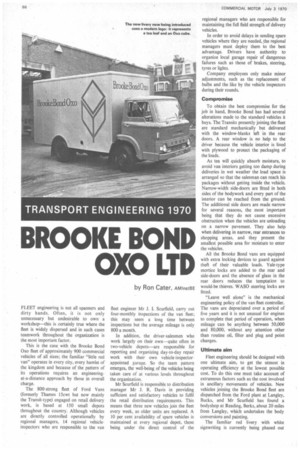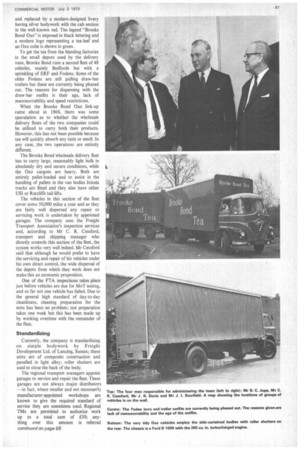BROOKE BOND OM LTD
Page 68

Page 69

Page 70

If you've noticed an error in this article please click here to report it so we can fix it.
by Ron Cater, AMInstBE
FLEET engineering is not all spanners and dirty hands. Often, it is not only unnecessary but undesirable to own a workshop—this is certainly true where the fleet is widely dispersed and in such cases teamwork throughout the organization is the most important factor.
This is the case with the Brooke Bond Oxo fleet of approximately 900 commercial vehicles of all sizes; the familiar "little red van" operates in every city, every hamlet of the kingdom and because of the pattern of its operations requires an engineeringat-a-distance approach by those in overall charge.
The 800-strong fleet of Ford Vans (formerly Thames 15cwt but now mainly the Transit-type) engaged on retail delivery work, is based at 150 small depots throughout the country. Although vehicles are directly controlled operationally by regional managers, 14 regional vehicleinspectors who are responsible to the van fleet engineer Mr J. I. Scurfield, carry out four-monthly inspections of the van fleet; this may seem a long time between inspections but the average mileage is only 800 a month.
In addition, the driver-salesmen who work largely on their own—quite often in two-vehicle depots—are responsible for reporting and organizing day-to-day repair work with their own vehicle-inspectorappointed garage. So the team pattern emerges, the well-being of the vehicles being taken care of at various levels throughout the organization.
Mr Scurfield is responsible to distribution manager Mr J. R. Davis in providing sufficient and satisfactory vehicles to fulfil the retail distribution requirements. This means that three new vehicles join the fleet every week, as older units are replaced. A 10 per cent availability of spare vehicles is maintained at every regional depot. these being under the direct control of the
regional managers who are responsible for maintaining the full field strength of delivery vehicles.
In order to avoid delays in sending spare vehicles where they are needed, the regional managers must deploy them to the best advantage. Drivers have authority to organize local garage repair of dangerous failures such as those of brakes, steering, tyres or lights.
Company employees only make minor adjustments, such as the replacement of bulbs and the like by the vehicle inspectors during their rounds.
Compromise To obtain the best compromise for the job in hand, Brooke Bond has had several alterations made to the standard vehicles it buys. The Transits presently joining the fleet are standard mechanically but delivered with the window-blanks left in the rear doors. A rear window is no help to the driver because the vehicle interior is lined with plywood to protect the packaging of the loads.
As tea will quickly absorb moisture, to avoid van interiors getting too damp during deliveries in wet weather the load space is arranged so that the salesman can reach his packages without getting inside the vehicle. Narrow-width side-doors are fitted in both sides of the bodywork and every part of the interior can be reached from the ground. The additional side doors are made narrow for several reasons, the most important being that they do not cause excessive obstruction when the vehicles are unloading on a narrow pavement. They also help when delivering in narrow, rear entrances to shopping areas, and they present the smallest possible area for moisture to enter the vehicles.
All the Brooke Bond vans are equipped with extra locking devices to guard against theft of their valuable loads. Yale-type mortice locks are added to the rear and side-doors and the absence of glass in the rear doors reduces the temptation to would-be thieves. WASO steering locks are fitted.
"Leave well alone" is the mechanical engineering policy of the van fleet controller. The vans are depreciated over a period of five years and it is not unusual for engines to complete that period of operation, when mileage can be anything between 50,000 and 80,000, without any attention other than routine oil, filter and plug and point changes.
Ultimate aim Fleet engineering should be designed with one ultimate aim, to get the utmost in operating efficiency at the lowest possible cost. To do this one must take account of extraneous factors such as the cost involved in ancillary movements of vehicles. New vehicles joining the Brooke Bond fleet are dispatched from the Ford plant at Langley. Bucks, and Mr Scurfield has found a bodyshop at Reading, Berks, about 20 miles from Langley, which undertakes the body conversions and painting.
The familiar red livery with white signwriting is currently being phased out and replaced by a modern-designed livery having silver bodywork with the cab section in the well-known red. The legend "Brooke Bond Oxo" is imposed in black lettering and a modern logo representing a tea-leaf and an Oxo cube is shown in green.
To get the tea from the blending factories to the small depots used by the delivery vans, Brooke Bond runs a second fleet of 48 vehicles, mainly Bedfords but with a sprinkling of ERF and Fodens. Some of the older Fodens are still pulling draw-bar trailers but these are currently being phased out. The reasons for dispensing with the draw-bar outfits is their age, lack of manoeuvrability and speed restrictions_ When the Brooke Bond Oxo link-up came about in 1968, there was some speculation as to whether the wholesale delivery fleets of the two companies could be utilized to carry both their products. However, this bas not been possible because tea will quickly absorb any taint or smell. In any case, the two operations are entirely different.
The Brooke Bond wholesale delivery fleet has to carry large, reasonably light bulk in absolutely dry and secure conditions, while the Oxo cargoes are heavy. Both are entirely pallet-loaded and to assist in the handling of pallets in the van bodies Joloda tracks are fitted and they also have either USI or Ratcliffe tail-lifts.
The vehicles in this section of the fleet cover some 50,000 miles a year and as they are fairly well dispersed any repair or servicing work is undertaken by appointed garages. The company uses the Freight Transport Association's inspection services and, according to Mr C. R. Cessford, transport and shipping manager who directly controls this section of the fleet, the system works very well indeed. Mr Cessford said that although he would prefer to have the servicing and repair of his vehicles under his own direct control, the wide dispersal of the depots from which they work does not make this an economic proposition.
One of the FTA inspections takes place just before vehicles are due for MoT testing, and so far not one vehicle has failed. Due to the general high standard of day-to-day cleanliness, cleaning preparation for the tests has been no problem; test preparation takes one week but this has been made up by working overtime with the remainder of the fleet.
Standardizing Currently, the company is standardizing on simple bodywork by Freight Development Ltd, of Lancing, Sussex; these units are of composite construction and panelled in light alloy; roller shutters are used to close the back of the body.
The regional transport managers appoint garages to service and repair the fleet. These garages are not always major distributors —in fact, where smaller and not necessarily manufacturer-appointed workshops are known to give the required standard of service they are sometimes used. Regional TMs are permitted to authorize Work up to a total sum of £50; anything over this amount is referred continued on page 68
to Mr Cessford at head office.
This wholesale delivery fleet is depreciated over a period of seven to eight years and repainted after five years; to get this length of service from the paintwork, the initial job must be a good one and most of the vehicles are brush-painted and varnished, the varnishing being redone between two and three years as required.
Such good results have been achieved with Michelin X tyres that these are now specified throughout the fleet. the company does not use recut or remoulded tyres at all.
Carrying the Oxo products is the task of some 80 vehicles under the direct control of Mr R. C. Jupp, who is also the chief motor vehicle buyer for the company. The needs of the Oxo section are changing and it now requires bigger vehicles than in the past. A sign of the times, this is due to the increased size of the premises to which the vehicles deliver—for example, the supermarkets which are replacing the small corner shops.
The engineering requirement of this section of the fleet is carried out by appointed garages selected by the depot superintendent where the vehicle is based. For major work two main workshops have been selected: one in the North of England and the other near London. Whereas vehicles at one time returned for an annual inspection, this system has recently been revised so that the return to the head office now coincides with the vehicle's annual appointment with the MoT..
To facilitate the fork-lift loading operations of the Oxo section, curtain-sided bodies have been developed in co-operation with Freight Development Ltd, of Lancing. These have plastics-coated side curtains arranged along the sides of the body permitting full access along the whole length of the vehicle.
Roller shutters close the rear of the body and the floors are designed to accept the distributed loading imposed by a 1-ton pallet. Joloda tracks are fitted in the floors to assist in handling the pallets when a fork-lift truck is not available.
Security
To assist in the protection of the valuable cargoes, steering-locks and alarms are fitted to all the machines. The vehicles currently being added to the fleet are Ford D1000 long-wheel base models powered by the 360 cu. in. turbocharged engine. Two-speed axles are not used, the transmission train being a five-speed overdrive gearbox and single-speed rear axle.
No • vehicle is subjected to unnecessary mechanical "fiddling" and, in the experience of the four men directly concerned, Mr Davis, Mr Jupp, Mr Cessford and Mr Scurfield, this system produces good results.
'This is a far-flung fleet and, in fact, few of its vehicles are ever seen by the controllers, not because they do not want to—they don't have to! The four men agreed that little trouble was experienced in the way of unscheduled stoppage. The team, it seems, has been developed to such a high pitch of efficiency that the innumerable deliveries made daily by the fleet are seldom disrupted.




































































































































































